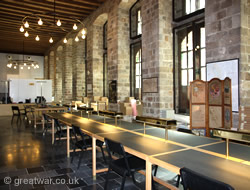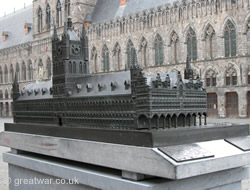The Cloth Hall (Lakenhalle) in Ieper/Ypres
The Cloth Hall, called the Lakenhalle in Flemish, is located in the centre of Ypres. “Laken” is the Flemish word for a type of high quality woollen woven cloth.
During medieval times the Cloth Hall was the commercial heart of the city in its role as the place where the trading of cloth and wool was carried out. At this time the city was very prosperous as one of the leading centres of the Flemish weaving industry.
The Halls
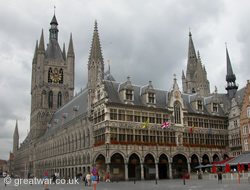
|
The Cloth Hall is, in fact, a series of buildings surrounding a rectangular courtyard. The building work was started in 1200 and took over 100 years to complete, being finished in 1304. There was a ground floor and an upper floor.
Until the mid 1840s the small Ieperlee river flowed through the town and past the western end of the Cloth Hall. Small boats with a low draft could make their way right up to the Cloth Hall from the Yser Canal to unload their goods into the halls.
Ground Floor Halls
The ground floor consisted of halls with vaulted brick ceilings. These halls were used for the sale and storage of goods and produce. To provide the traders, merchants and customers with easy access to the ground floor halls and stores there were 48 doors on the southern façade opening out onto the market square.
The main trade carried out in the Cloth Hall was the merchandising of cloth and wool, but it was also used on market day for the sale of vegetables and other goods.
Upper Floor Halls
The upper floor also consisted of more interconnecting halls. Some of them were more richly decorated than others. The roof of this upper floor level was made up of huge wooden beams. These halls were used by the merchants as a banqueting hall, warehouses, as meeting rooms by tradesmen's guild members and aldermen of the city (council members or representatives of the judiciary of the area).
In one of the upper halls the walls were decorated with 12 fresoes by Ferdinand Pauwels. These wall-paintings showed scenes from the prosperous period of history of the town between 1187 and 1383. Other walls were decorated with paintings of a cloth merchant by the artist Louis Delbeke.
The Aldermen's Hall was located in the northern part of the building on the upper floor. It's interior decoration was especially impressive. It contained 19th century mural paintings by Godfried Guffens and Jan Swerts, intricate carvings, a rose window for the aldermen's chapel and a huge mantlepiece surrounding a stone fireplace. A door led off to the east of this hall into an adjoining hall where the Alderman's Chapel was located.
The Nieuwerck

|
The Nieuwerck is a later part of the Cloth Hall building constructed onto its eastern end. This annex was built in the 17th century Renaissance style between 1619-1622. There are two upper floors, the first floor connects to the upper floor of the gothic Cloth Hall.
the Nieuwerck underwent restoration in 1862. This part of the Cloth Hall contained a chapel, frescoes, stained glass windows and a fireplace, murals and a frieze illustrating the Counts of Flanders. In 1914 the Sheriff's Room was located in the Nieuwerck.
The first and second floors of the Nieuwerck are supported by a line of pillars, which creates a covered walkway with a vaulted ceiling across the east end of the Cloth Hall. This walkway leads to St. Martin's cathedral.
The Belfry Tower
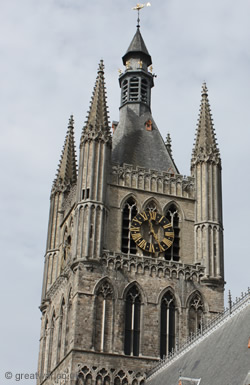
|
The belfry was the oldest part of the Lakenhalle complex. The foundation stone was laid in 1201 by Baudoin IX, Count of Flanders. The purpose of the bell tower was that it was originally a watchtower for the protection of the people and their property in the town. There was a watchman on 24 hour duty to keep watch against invaders and fire. The tower contained bells with which the watchman would warn the inhabitants of danger.
There were three floors in this bell tower. At one time the ground floor was used as a prison. From the 14th century the belfry also served as the Hôtel de Ville (the Town Hall). It was used as a treasury and armoury and it was also used for meetings by the various Guild representatives. The town archives and Guild charters were once stored in the belfry tower.
Black Magic and Black Cats
In days gone by black cats were ceremonially thrown from the belfry because they were considered to be associated with black magic. Nowadays the city holds a “Cats Festival” every three years when stuffed toy cats are thrown from the belfry during the festival.
The Carillon
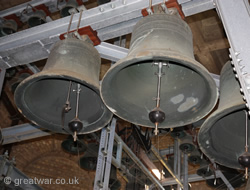
|
The belfry currently contains 49 bells in a carillon. At certain hours of the day the carillon plays, sending the magical notes of the bells across the town. Performances of the carillon are given on special days of the year, such as the anniversary of Armistice Day on 11th November.
Donkerpoort
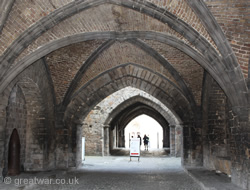
|
The Donkerpoort is a dark passageway through a central archway located in the ground floor of the belfry on the centre of the southern façade. The passageway leads from the south side of the Cloth Hall on the market square, Grote Markt, through the centre of the building complex to the north side of the Cloth Hall and St. Martin's cathedral.
In the centre of the passageway there are two gateways to the left and right, which each lead into a courtyard in the centre of the Cloth Hall complex.
The Stone Lions of Ypres
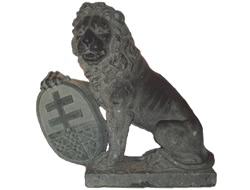
|
at the western end of the south façade there was once a stone set of steps leading from the market square up to the first floor of the upper halls. The steps were close to where the boats could land their goods at the western end of the Cloth Hall from the small Ieperlee river.
During restoration work on the Cloth Hall in 1848 these steps were removed. At the foot of the staircase there were two seated stone lions, each one facing the other on each side of the steps. Each lion was holding a shield with the coat of arms of the City of Ypres. The symbol of the lion was part of the coat of arms of the city of Ieper. These lions were sculpted by Monsieur Dubois of Zennick.
When the steps were removed the lions were placed in an unknown location for safekeeping for about 20 years. It was decided to take both of the stone lions to the Menin Gate, the eastern entrance into the city. In 1862 the lions were lifted onto a stone pedestal on each side of the gateway. They continued to guard this entrance to the city for the next 60 years until they were moved from the Menin Gate to prevent them being destroyed when the Great War came to Ypres.
Destruction of the Cloth Hall 1914-1918
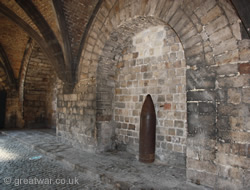
|
The first damage to the the Cloth Hall and the Belfry occurred as the First Battle of Ypres drew to a close in mid November 1914. The British defence was holding east of the city of Ypres and it became clear to the German Army that it was not going to be able to capture Ypres after all. A German artillery bombardment of the city then began to grow in intensity. The Cloth Hall was slightly damaged by two German artillery shells on 5th November. On 21 November an artillery shell hit the Nieuwerck and some of the gable collapsed.
The next day, on 22 November, German incendiary devices hit the Cloth Hall and it was set on fire. Unfortunately a wooden scaffold on the belfry intensified the flames and the wooden beamed roofs of the halls on the upper floors were burnt out. The reason there was scaffolding on the belfry was because a local stonemason called Alphonse Angillis was restoring the belfry tower of the Cloth Hall. Tragically he had just about finished the work when the war came to Ypres. Alphonse was a big man who was nicknamed “the Bear”. He was well-known in Ypres and was one of the last civilians to leave the city when the military finally evacuated the local population in April 1915.
The destruction of the Cloth Hall by the German Army began from this time when a German armoured train and long range gun was brought up the line to Houthem. Observation balloons directed the firing of incendiary and explosive shells onto the city. By December 1914 the Cloth Hall had been seriously damaged.

|
A few months later, from mid April 1915, Ypres began to be shelled by long range German heavy howitzers from positions several kilometres east of the city. This was specifically to draw Allied attention away from secret preparations being made by the German Army to carry out a trial of a new weapon, poisonous gas. On Monday 19 April one of the German Army's two huge German 42cm guns “Big Bertha” joined in. It had been brought to the Houthulst Forest by rail. With the destructive capabilities of this huge gun the Germans began a systematic demolition of the medieval city.
All the unique works of art in the upper halls were destroyed. The buildings making up the complex of the Cloth Hall were completely destroyed by 1918. Only a small part of the belfry tower walls remained standing, becoming an iconic image of the devastated city.
Post War Reconstruction
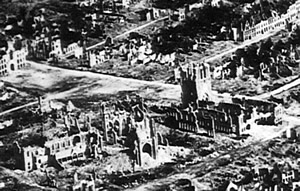
|
The rebuilding of the Cloth Hall was started in 1928 and its reconstruction was finished in 1967. The architects were J. Coomans and P.A. Pauwels. New visitors to the city are amazed to discover that the Cloth Hall now standing is a recent construction. The Cloth Hall and belfry have been painstakingly rebuilt in keeping with their historical past. As with so many other “historic” buildings in Ypres, it is hard to appreciate that they have been raised again from the ruins and the rubble.
In 1999 UNESCO inscribed 32 belfry towers into a list of Belfries of Flanders and Wallonia. The belfry tower of Ypres is one of these and is, therefore, now one of a group of 56 belfries across Belgium and France designated as a World Heritage Site.
Ieper Town Hall
The Nieuwerck at the eastern end of the Cloth Hall is the location of the Town Hall.
Ieper Tourist Office
The Tourist Office is located in the Cloth Hall. The entrance is situated on the southern façade of the building.
Ieper (Ypres) Tourist OfficeIn Flanders Fields Museum
The award-winning museum is housed in the western section of the Cloth Hall. It is dedicated to the First World War. The exhibitions and displays illustrate how the war affected the city of Ypres and the people, local civilians and the military forces, who lived through the difficult years of 1914 to 1918 in the region.
In 2010-2012 the museum underwent a major renovation, taking on more floor space in the Cloth Hall. The museum's extensive archive is now housed within the same building as the exhibition space.
In Flanders Fields MuseumLocation of Ypres Cloth Hall (Lakenhalle)
Parking
There is metred parking on the market square next to the Cloth Hall. Alternatively there is parking on the north side of the Cloth Hall in the square of Vandenpeerboomplein and next to St. Martin's cathedral. On Saturdays there is a market which fills the square, and the whole square is used several times during the year for special events.
Public Toilets
There are public toilets on the north side of the Cloth Hall.
Related Topic
Information about the bronze replica by Georges Baert of the Cloth Hall.

